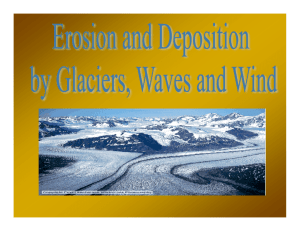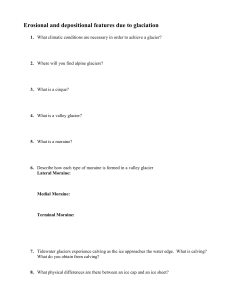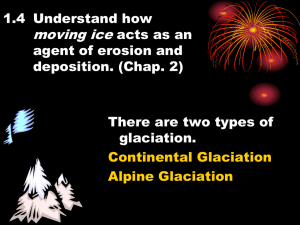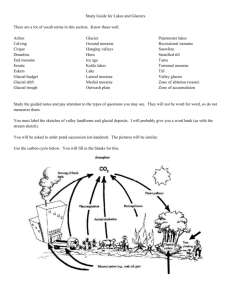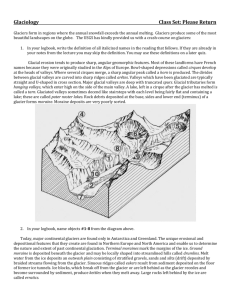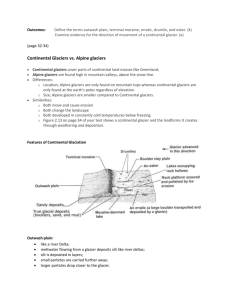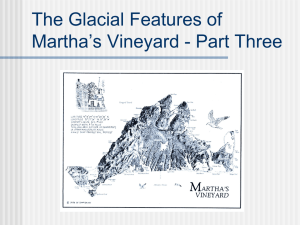unit 1 part 6a glacier erosion
advertisement
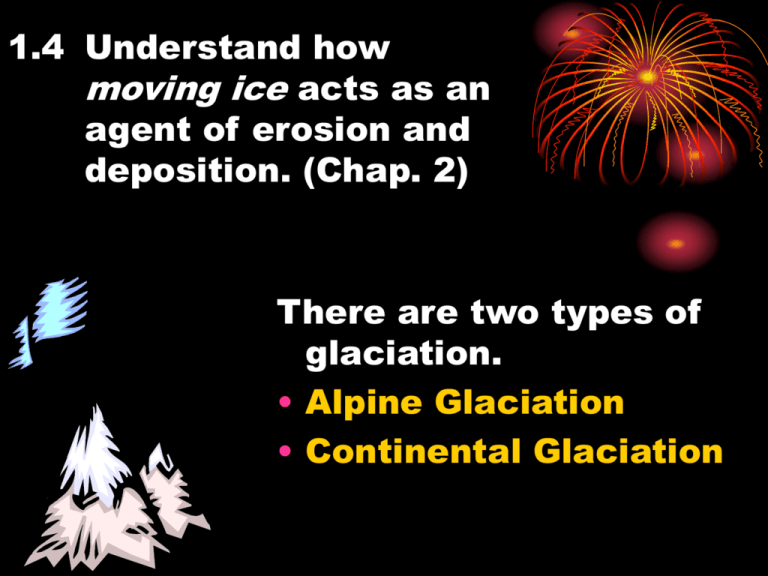
1.4 Understand how moving ice acts as an agent of erosion and deposition. (Chap. 2) There are two types of glaciation. • Alpine Glaciation • Continental Glaciation Distinguish between the terms alpine glaciation and continental glaciation. (P.32) Alpine Glaciation • Alpine glaciers form high in mountain valleys; above the snow-line C D E B A Alpine Glaciation Continental Glaciation • Continental glaciers cover parts of continental land masses; ex Greenland Distinguish between the terms alpine glaciation and continental glaciation. (P.32) Similarities Differences • Both move and cause erosion • Both change the landscape • Both developed in constantly cold < 0 0C • Location • Alpine = mountain • Continental = earth poles • Size • Alpine = smaller • Continental = larger Define the terms outwash plain, terminal moraine, erratics, drumlins & eskers. (P. 33 Q.12) • These features are associated with continental glaciation. • See picture p. 34 Outwash plain Outwash plain • Similar to a river delta • Melt water flowing from the glacier deposits silt • Deposited in layers • Small particles carried further away • Larger particles drop closer to the glacier Outwash Plain Continental…Outwash plain Outwash Plain Continental…Outwash plain Continental…Outwash plain Terminal moraine • Heap or ridge of bulldozed gravel that marks the end of the forward motion of a glacier • As glacier retreats it deposits debris/gravel • P. 34 Continental…Terminal Moraine Terminal Moraine Outwash Plain Continental…Terminal Moraine Erratics • Large boulders that were transported long distances and dropped • They now sit in a region and look very much out-of-place. • P. 34 Erratic Erratic Continental…Erratic Terminal Moraine Outwash Plain Erratic Drumlins p. 34 • Egg shaped hill • Formed under glaciers • Sloped or Pointy end points in direction of ice flow Drumlins p. 34 • Formation • Ice melts under glacier • Deposits of gravel made • Glacier moves forward • Deposits are bull-dozed along and catches up in rough areas forming piles or drumlins. Drumlin What direction did the glacier move? Continental…Drumlin Drumlins Terminal Moraine Outwash Plain Erratic Esker p. 34 • Long deposits of eroded glacial material • Formed by sub-glacial streams that deposit material like all rivers. • Highways of the North!! Esker Esker Continental…Esker Drumlins Terminal Moraine Esker Outwash Plain Erratic Examine evidence for the direction of movement of glaciers. (P. 34 question # 13) 1. Sloped end of drumlin 2. Location of terminal moraine • What is direction of glacier movement in this picture? Continental…Outwash Plain Define the terms cirque, arête, hanging valley, lateral moraine, and terminal moraine. (P. 36) • These features are associated with alpine glaciers Alpine glaciers • Alpine glaciers are like very slow moving rivers of ice flowing down high mountain valleys. Cirque (p. 36) • a circular hollow cut into bedrock during glaciation • Side and back walls are steep but front wall opens downward Cirque - How formed? • Alpine glacier freezes onto mountain valley and as is proceeds it plucks rock from the mountain top leaving the cirque shape. C D E Cirque B A Cirque Arête p. 36 • Steep, jagged, narrow, knife edged ridge between two cirques or glacier valleys. Arete C D E Cirque B A Arête Truncated Spur • Blunt-ended ridge of rock jutting from the side of a glacial trough, or valley Arete C Truncated spurs A D E Cirque B Horn or Pyramidal Peak • is a mountaintop (peak) that has been modified by the action of ice during glaciation. Arete C Truncated spurs A Horn D E Cirque B Horn Hanging Valley Most noticeable once glacier has melted! • A high level tributary valley from which the ground falls sharply to the level of the lower, main valley. • The depth of the lower valley is due to more severe glaciation. Hanging Valley Hanging Valley Hanging Valley in Newfoundland • Hanging Valley in Gros Morne National park . • Trout River pond Lateral Moraine • Moraine means 'rock waste'.It is also known as glacial till • Lateral Moraine is the land-form deposited at the side of a glacier • Debris/waste rock drops off the side of the mountain as the glacier moves forming a ridge of debris at the outer-sides of the glacier. Lateral Moraine •Lateral Moraines Kaskawulsh Glacier St. Elias Mtns - Arctic Terminal Moraine • deposits that mark the farthest extent of the glacier • Good indicator of the direction or movement of the glacier as well. Alpine Glaciation • Terminal Moraine Medial Moraine • This is a ridge of rock waste found along the middle of the floor of a u - shaped valley. • It occurs when two glaciers meet, two lateral moraines unite to form a medial moraine. Medial Moraine •Medial Moraine Medial Moraine • Medial Moraine Alpine Glaciation Kaskawulsh Glacier St. Elias Mtns - Arctic Describe how fiords are formed. (P.37) 1. Alpine Glaciers erode troughs & valleys in the mountain 2. Glacier valley reaches the coast. 3. Glacier melts and sea water floods the valley Fiord • A glacially eroded or modified U-shaped valley that extends below sea level and connects to the ocean. Filled with seawater… Gross Morne - Fiord Fiord in Norway • Norway is well known for its abundant fiords Continental Glacier

